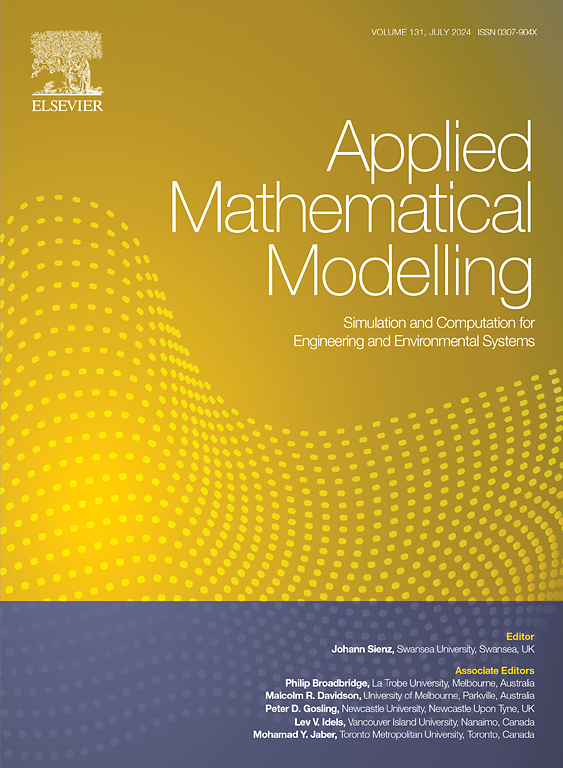Analytical solutions of curvilinear nano-beams: An application to nano-circular ring problems and gradient initial stresses
IF 4.4
2区 工程技术
Q1 ENGINEERING, MULTIDISCIPLINARY
引用次数: 0
Abstract
This study investigates the analytical solutions for homogeneous, not only isotropic but also anisotropic curved nano-beams with axial symmetry and extends classical elasticity (CE) to gradient elasticity (GE). The stress fields are determined using a gradient Airy stress function, which corresponds to the classical Airy stress potential. For both cases, the gradient Airy stress functions are derived from analytical solutions of the governing differential equations, which are written in the form of the (classical) Airy stress function. The corresponding stress in GE is determined for different cases with displacement fields derived from CE. The analytical solutions show that GE stresses and displacement fields contain expressions with Bessel and hypergeometric functions. These solutions make it possible to compare the CE and GE stress and displacement fields. As an application, the stress and displacement fields for a nano-circular ring representing a multiply connected body are solved analytically for classical and nano-scale cases. In addition, the initial stresses are extended to GE for nested rings, where the GE initial stresses are introduced. Finally, it is shown analytically and numerically that the GE solutions for all derived stress and displacement fields, including the gradient Airy stress functions, approach CE when the gradient coefficient c converges to zero.
曲线纳米梁的解析解:在纳米环问题和梯度初始应力中的应用
本文研究了轴对称均质、各向同性和各向异性弯曲纳米梁的解析解,并将经典弹性理论扩展到梯度弹性理论。采用梯度艾里应力函数确定应力场,该函数对应于经典艾里应力势。对于这两种情况,梯度Airy应力函数都是由控制微分方程的解析解推导出来的,该方程以(经典)Airy应力函数的形式表示。在不同的情况下,利用由位移场推导出的位移场,确定了相应的应力。解析解表明,GE应力场和位移场包含贝塞尔函数和超几何函数的表达式。这些解决方案使得比较CE和GE的应力场和位移场成为可能。作为应用,本文在经典和纳米尺度下解析求解了代表多连通体的纳米环的应力场和位移场。此外,对于嵌套环,初始应力扩展到GE,其中引入GE初始应力。最后,通过解析和数值计算表明,当梯度系数c收敛于零时,所有导出的应力场和位移场(包括梯度Airy应力函数)的GE解都接近CE。
本文章由计算机程序翻译,如有差异,请以英文原文为准。
求助全文
约1分钟内获得全文
求助全文
来源期刊

Applied Mathematical Modelling
数学-工程:综合
CiteScore
9.80
自引率
8.00%
发文量
508
审稿时长
43 days
期刊介绍:
Applied Mathematical Modelling focuses on research related to the mathematical modelling of engineering and environmental processes, manufacturing, and industrial systems. A significant emerging area of research activity involves multiphysics processes, and contributions in this area are particularly encouraged.
This influential publication covers a wide spectrum of subjects including heat transfer, fluid mechanics, CFD, and transport phenomena; solid mechanics and mechanics of metals; electromagnets and MHD; reliability modelling and system optimization; finite volume, finite element, and boundary element procedures; modelling of inventory, industrial, manufacturing and logistics systems for viable decision making; civil engineering systems and structures; mineral and energy resources; relevant software engineering issues associated with CAD and CAE; and materials and metallurgical engineering.
Applied Mathematical Modelling is primarily interested in papers developing increased insights into real-world problems through novel mathematical modelling, novel applications or a combination of these. Papers employing existing numerical techniques must demonstrate sufficient novelty in the solution of practical problems. Papers on fuzzy logic in decision-making or purely financial mathematics are normally not considered. Research on fractional differential equations, bifurcation, and numerical methods needs to include practical examples. Population dynamics must solve realistic scenarios. Papers in the area of logistics and business modelling should demonstrate meaningful managerial insight. Submissions with no real-world application will not be considered.
 求助内容:
求助内容: 应助结果提醒方式:
应助结果提醒方式:


